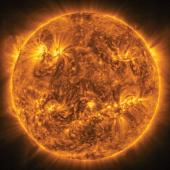Orion in Winter
Whether you prowl the winter landscape in snowshoes, skis, or your favorite pack boots, look skyward whenever your adventures keep you outside at nightfall. You’ll find a fellow sportsman in the heavens in the glittering figure of the constellation Orion, the hunter.
Orion is easy to find thanks to his signature belt of three bright stars, contained within a rectangle of more bright stars outlining his brawny body; he throws a leg over the eastern horizon and rises into the sky by nightfall in December. By early March, he lies due south by the time it gets dark.
Orion's figure is made mostly of blue-white stars hotter and brighter than our sun, although orangey Betelgeuse, marking his right shoulder, has already passed into old age. This bloated red supergiant star may pop as a supernova within the next million years or so. Aim a pair of binoculars below Orion's belt, at the fainter line of stars that marks his sword, and the middle will glow as a faint whitish patch of gas. Photographic exposures of this space cloud or “nebula” (specifically the Orion Nebula) show it vivid red: the light of hydrogen gas excited into glowing by the energy of newborn stars embedded in this stellar nursery.
Anyone so prominent as Orion is bound to be gossiped about, and one of the old Greek tales links him with Artemis (the Roman Diana), the virgin goddess of the moon, who was sweet on the big galoot. Artemis’s brother, the sun god Apollo, was not, however, amused. One day when brother and sister strolled a golden beach, Apollo teased his sister about her prowess with the bow and arrow, daring her to hit a tiny black speck bobbing far out to sea. Artemis, no slouch in archery competitions, bent her bow and sent her arrow straight and true, and the bullseyed black speck disappeared beneath the waves. Imagine her chagrin when she learned that her target had been nothing other than the head of Orion, who had been taking a salty dip before Artemis’ arrow sent him to sleep with the fishes.
The gods made amends as best they could by placing Orion in the sky, below the monthly track of the moon. And so every month, Artemis sails by close enough to tousle his hair. When the moon is elsewhere, Orion has his hunting dogs to keep him company. Follow the line of his belt stars down and left to find white Sirius, the brightest star in Canis Major, the Great Dog—as well as the brightest star in the sky. Trace up and left of Sirius to find yellowish Procyon, the main star of Canis Minor, the Little Dog. Trace rightward back to orange Betelgeuse, and you’ll see that these three stars make a colorful triangle in the sky—as colorful as the characters they adorn.
They’re all out there; all it takes to see them is a little imagination, one or two hot toddies from the lodge, and a walk in the nippy air to look for the signpost of Orion’s twinkling belt as he snowshoes across the celestial landscape of winter.











